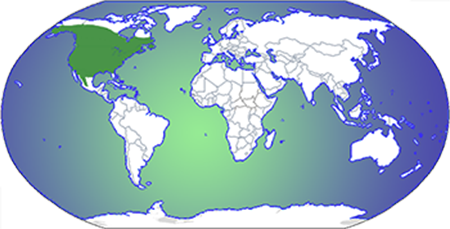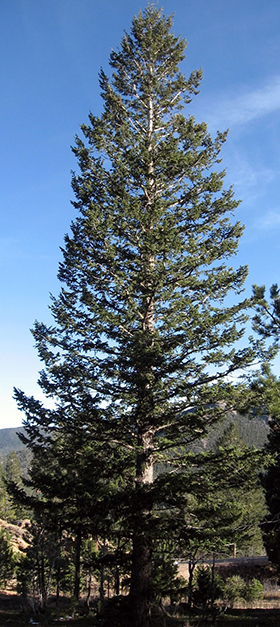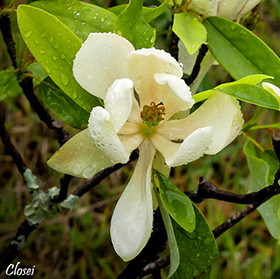climate determines distribution
Overview
The trees of North America extend from the Arctic Circle to subtropical Mexico. The varied topography of this large land mass influences temperature, rainfall and soils, broadly dividing the plants into eastern, western and southern groups. Canada and north-eastern USA are described as cold and moist (the average January day temperature in Chicago is -3oC), while the south-eastern states are warm and rainy. Moving west, much of the inland and northern Mexico is semi-arid or desert; further west the Pacific coast is wet, and ranges from hot in California to cool in the north.
»Follow this link to view a map with the locations of the collection highlighted.

North East
Cold air masses from the polar regions influence the distribution of the conifer and mixed hardwood forests of the north east. In these forests live trees that also occur in Europe and Asia: the deciduous oaks, beech, maples, elms, and birches, as well as conifers: firs, spruces and pines. These common species support the theory that the northern continents were once joined as the supercontinent Laurasia.
The dense forests have produced a wealth of valuable commercial hardwood timber such as shagbark hickory (Carya ovata) and black walnut (Juglans nigra).
Sugar maple (Acer saccharum) is tapped for its syrup, which is produced only in cold conditions. Warming of the climate has pushed the sugar maple's range further north and to higher elevations.
The popular ornamental trees scarlet oak (Quercus coccinea) and liquidambar (Liquidambar styraciflua) come from these forests.
West Coast

From the great belt of coniferous forest around the North Pole, mixed forests of pines, firs and spruces reach down the mountain ranges that spread into Asia, Europe and North America.
Primarily found in the wet, northern parts of the North American west coast are the cone-bearing trees: the firs, cedars, pines, junipers and cypress, as well as the redwoods. About 40 species of redwood flourished in northern hemisphere forests some 60 million years ago, but today only two species survive. The big tree (Sequoiadendron giganteum) is limited to the western side of the Sierra Nevada Range at altitudes of 1200 to 1500 metres; the coast redwood (Sequoia sempervirens) is more widespread. Both species are long lived, have a high resistance to fires, insects and disease, and commonly exceed 70 metres in height.
This is the home of one of the world's most important and valuable timber trees, the Douglas-fir (Pseudotsuga menziesii). Also called Oregon pine, Douglas-fir has been a major component of the forests of western North America for the past million years, and has been successfully introduced in the last 100 years into many regions of the temperate forest zone. The altitudinal distribution of both varieties of Douglas-fir (menziesii and glauca) increases from north to south, reflecting the effect of a warmer climate. The principal limiting factors are temperature in the north of the range and moisture in the south. Generally, the variety glauca grows at considerably higher altitudes than the coastal variety of comparable latitude.
Douglas-fir grows under a wide variety of climatic conditions: the more rapidly growing and much larger coast Douglas-fir (P. menziesii var. menziesii) is a green variety indigenous to the Pacific Coast Ranges. This coastal region has a maritime climate characterised by mild, wet winters and cool, relatively dry summers, a long frost-free season, and narrow daytime fluctuations of temperature (6° to 8° C); and the significantly more cold-hardy blue Douglas-fir (P. menziesii var. glauca) native to the interior mountains is more shade tolerant and has a more pronounced tap root. Winters are longer and colder with much of the precipitation falling as snow, summers are hot and in some places very dry, frost-free seasons are shorter, and daytime fluctuations of temperature are larger (10° to 16° C).
South East
In the south east and along the coast of the Gulf of Mexico are forest remnants from a warm, humid climate. This climate is influenced by the Equatorial ocean current entering the Gulf, bringing warm, moist tropical air.
Species found here include the bald cypress (Taxodium distichum), a deciduous conifer that is often seen in movies about the south. Growing in swamps, with spanish moss (Tillandsea species) hanging from its branches, it is distributed from Georgia to Mexico. In our Arboretum it can be seen on the island in Founder's Lake.
In the same region is the bull bay, Magnolia grandiflora, a tree popular in gardens from the early Victorian period and introduced to Tasmania as early as 1834. The magnolias in this collection were planted in 2005 near the start of the Sylvan Circuit.
»Follow this link to view the full interpretive panel in PDF format.
